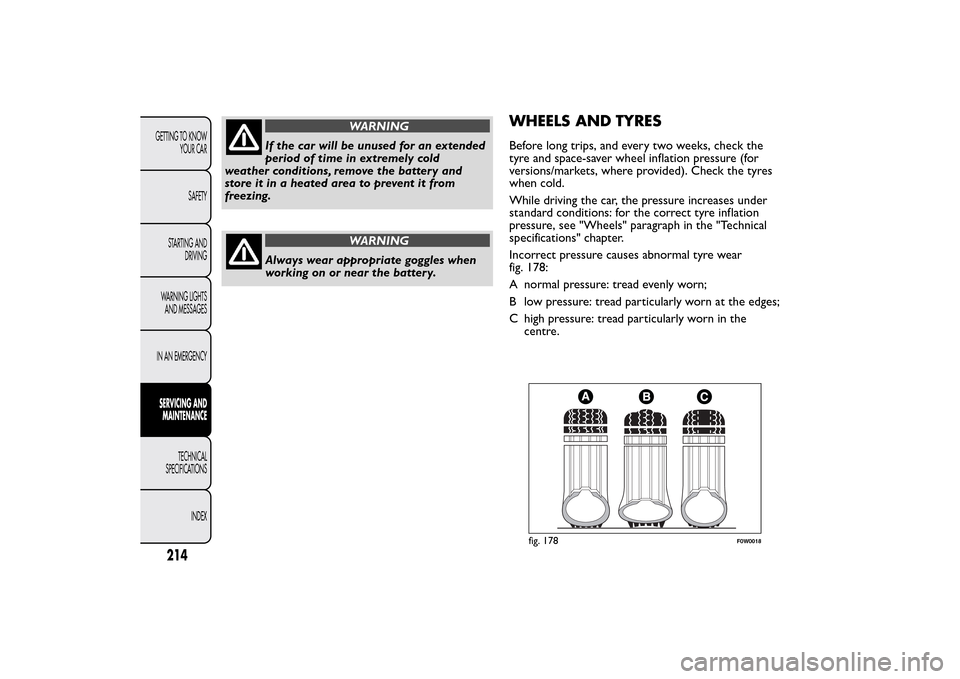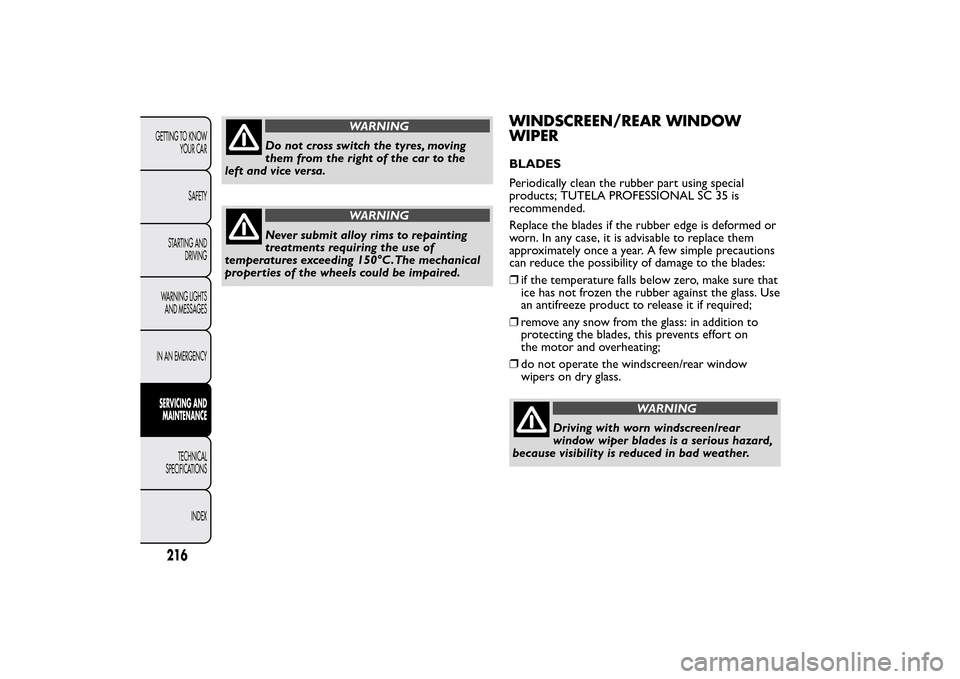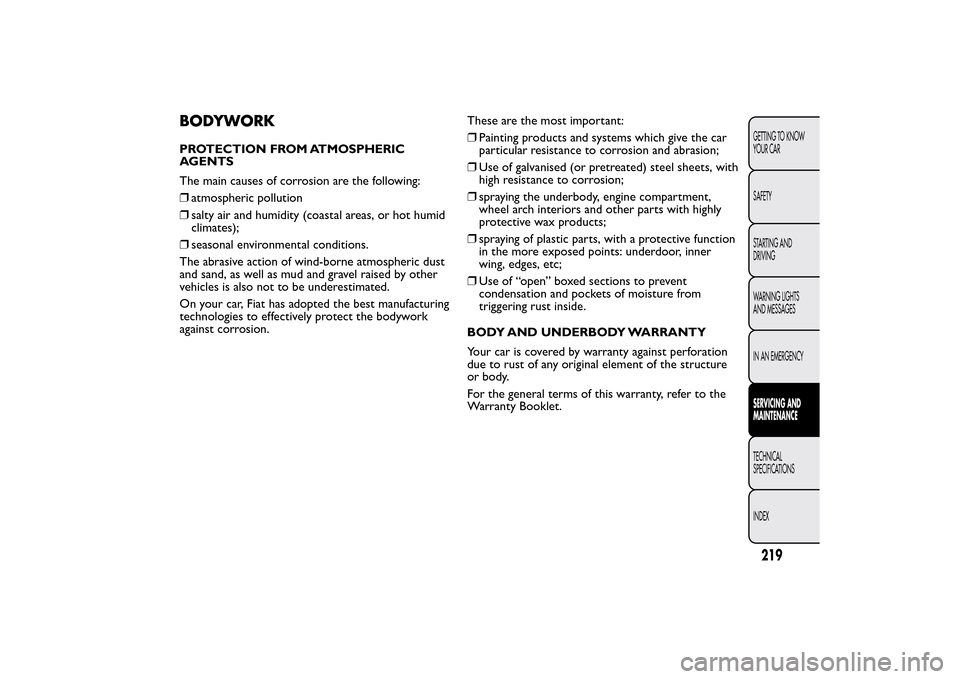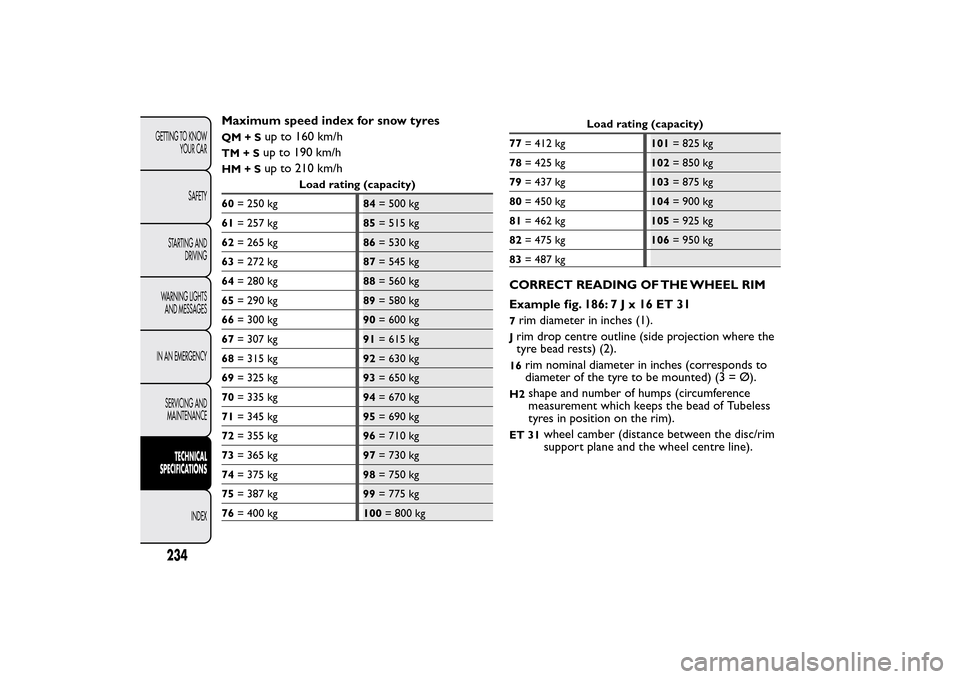Page 218 of 275

WARNING
If the car will be unused for an extended
period of time in extremely cold
weather conditions, remove the battery and
store it in a heated area to prevent it from
freezing.
WARNING
Always wear appropriate goggles when
working on or near the battery.
WHEELS AND TYRESBefore long trips, and every two weeks, check the
tyre and space-saver wheel inflation pressure (for
versions/markets, where provided). Check the tyres
when cold.
While driving the car, the pressure increases under
standard conditions: for the correct tyre inflation
pressure, see "Wheels" paragraph in the "Technical
specifications" chapter.
Incorrect pressure causes abnormal tyre wear
fig. 178:
A normal pressure: tread evenly worn;
B low pressure: tread particularly worn at the edges;
C high pressure: tread particularly worn in the
centre.
fig. 178
F0W0018
214GETTING TO KNOW
YOUR CAR
SAFETY
STARTING AND
DRIVING
WARNING LIGHTS
AND MESSAGES
IN AN EMERGENCYSERVICING AND
MAINTENANCE
TECHNICAL
SPECIFICATIONS
INDEX
Page 219 of 275

The tyres must be replaced when the tread is less
than 1.6 mm thick. In any case, follow the laws
in force in the country where you are driving.
IMPORTANT
Take the following precautions to prevent damage to
the tyres:
❒avoid braking suddenly, racing starts and violent
impact against the curb, potholes or other
obstacles and driving for extended periods on
uneven road surfaces;
❒periodically check that the tyres have no cuts in
the side wall, abnormal swelling or irregular tyre
wear;
❒avoid travelling with the car overloaded. If you
have a puncture, stop immediately and change the
tyre;
❒tyres age even if they are not used much. Cracks in
the tread rubber and at the sides are a sign of
ageing. In any case, if the tyres have been on the
car for over 6 years, they should be checked
by specialised personnel. Also remember to check
the space-saver wheel very carefully (for
versions/markets, where provided);❒change the position of the tyres every 10-15
thousand kilometres, keeping them on the same
side of the car to avoid inverting the rotation
direction;
❒In the case of replacement, always fit new tyres,
avoiding those of dubious origin;
❒if a tyre is changed, also change the inflation valve.
WARNING
The road holding qualities of the car
also depend on the correct inflation
pressure of the tyres.
WARNING
If the pressure is too low the tyre
overheats and can be seriously
damaged.
215GETTING TO KNOW
YOUR CAR
SAFETY
STARTING AND
DRIVING
WARNING LIGHTS
AND MESSAGES
IN AN EMERGENCYSERVICING AND
MAINTENANCETECHNICAL
SPECIFICATIONS
INDEX
Page 220 of 275

WARNING
Do not cross switch the tyres, moving
them from the right of the car to the
left and vice versa.
WARNING
Never submit alloy rims to repainting
treatments requiring the use of
temperatures exceeding 150°C.The mechanical
properties of the wheels could be impaired.
WINDSCREEN/REAR WINDOW
WIPERBLADES
Periodically clean the rubber part using special
products; TUTELA PROFESSIONAL SC 35 is
recommended.
Replace the blades if the rubber edge is deformed or
worn. In any case, it is advisable to replace them
approximately once a year. A few simple precautions
can reduce the possibility of damage to the blades:
❒if the temperature falls below zero, make sure that
ice has not frozen the rubber against the glass. Use
an antifreeze product to release it if required;
❒remove any snow from the glass: in addition to
protecting the blades, this prevents effort on
the motor and overheating;
❒do not operate the windscreen/rear window
wipers on dry glass.
WARNING
Driving with worn windscreen/rear
window wiper blades is a serious hazard,
because visibility is reduced in bad weather.
216GETTING TO KNOW
YOUR CAR
SAFETY
STARTING AND
DRIVING
WARNING LIGHTS
AND MESSAGES
IN AN EMERGENCYSERVICING AND
MAINTENANCE
TECHNICAL
SPECIFICATIONS
INDEX
Page 223 of 275

BODYWORKPROTECTION FROM ATMOSPHERIC
AGENTS
The main causes of corrosion are the following:
❒atmospheric pollution
❒salty air and humidity (coastal areas, or hot humid
climates);
❒seasonal environmental conditions.
The abrasive action of wind-borne atmospheric dust
and sand, as well as mud and gravel raised by other
vehicles is also not to be underestimated.
On your car, Fiat has adopted the best manufacturing
technologies to effectively protect the bodywork
against corrosion.These are the most important:
❒Painting products and systems which give the car
particular resistance to corrosion and abrasion;
❒Use of galvanised (or pretreated) steel sheets, with
high resistance to corrosion;
❒spraying the underbody, engine compartment,
wheel arch interiors and other parts with highly
protective wax products;
❒spraying of plastic parts, with a protective function
in the more exposed points: underdoor, inner
wing, edges, etc;
❒Use of “open” boxed sections to prevent
condensation and pockets of moisture from
triggering rust inside.
BODY AND UNDERBODY WARRANTY
Your car is covered by warranty against perforation
due to rust of any original element of the structure
or body.
For the general terms of this warranty, refer to the
Warranty Booklet.
219GETTING TO KNOW
YOUR CAR
SAFETY
STARTING AND
DRIVING
WARNING LIGHTS
AND MESSAGES
IN AN EMERGENCYSERVICING AND
MAINTENANCETECHNICAL
SPECIFICATIONS
INDEX
Page 228 of 275
LEATHER STEERING WHEEL/GEAR
KNOB/HANDBRAKE
These components must be cleaned with mild soap
and water only. Never use alcohol or alcohol-based
products.
Read the product label carefully before using specific
products for cleaning the interiors: make sure the
product does not contain alcohol or alcohol-based
substances.
If, when cleaning the windscreen with special
products, window cleaner accidentally drips onto the
leather of the steering wheel/gear lever knob/hand
brake, wipe away immediately and then wash the
affected area with mild soap and water.IMPORTANT Be careful when using a steering wheel
lock device, where applicable, to avoid damaging
the leather upholstery by rubbing.
224GETTING TO KNOW
YOUR CAR
SAFETY
STARTING AND
DRIVING
WARNING LIGHTS
AND MESSAGES
IN AN EMERGENCYSERVICING AND
MAINTENANCE
TECHNICAL
SPECIFICATIONS
INDEX
Page 235 of 275
BRAKESVersionsFront service
brakesRear service
brakesParking brake
1.6 MultiJet - 2.0 MultiJetSelf-ventilated disc DiscControlled by hand
lever, acting on the
rear brakesIMPORTANT Water, ice and salt spread on the roads may deposit on the brake discs reducing braking
efficiency the first time the brakes are applied.SUSPENSIONVersions Front Rear
1.6 MultiJet - 2.0 MultiJetMacPherson independent wheels
with anti-roll barInterconnected wheels with
torsion beam
231GETTING TO KNOW
YOUR CAR
SAFETY
STARTING AND
DRIVING
WARNING LIGHTS
AND MESSAGES
IN AN EMERGENCY
SERVICING AND
MAINTENANCETECHNICAL
SPECIFICATIONSINDEX
Page 237 of 275

WHEELSRIMS AND TYRES
Pressed steel or alloy rims. Tubeless radial carcass
tyres. The vehicle registration document also lists all
type-approved tyres.
IMPORTANT If there are any discrepancies between
the Owner Handbook and the registration
document, take the information from the latter. For
safe driving, the car must be fitted with tyres of
the same make and type on all wheels.
IMPORTANT Do not use air chambers with Tubeless
tyres.
SPARE WHEEL
Pressed steel rim. Tubeless tyre.
WHEEL GEOMETRY
Front wheel toe-in measured from rim to rim:
-1mm+/-1mm
The values refer to the car in running order.
CORRECT TYRE READING
Example fig. 186: 195/55 R 16 91V195
Nominal width (S, distance in mm between
sidewalls)
55
Height/width ratio (H/S) as a percentage
RRadial tyre
16
Rim diameter in inches (Ø)
91
Load rating (capacity)
V
Maximum speed rating
Maximum speed rating
Q
up to 160 km/h
Rup to 170 km/hSup to 180 km/hT
up to 190 km/h
U
up to 200 km/h
H
up to 210 km/h
V
up to 240 km/h
W
up to 270 km/h
Y
up to 300 km/hfig. 186
F0Q0200
233GETTING TO KNOW
YOUR CAR
SAFETY
STARTING AND
DRIVING
WARNING LIGHTS
AND MESSAGES
IN AN EMERGENCY
SERVICING AND
MAINTENANCETECHNICAL
SPECIFICATIONSINDEX
Page 238 of 275

Maximum speed index for snow tyresQM+S
up to 160 km/h
TM+S
up to 190 km/h
HM+S
up to 210 km/h
Load rating (capacity)
60= 250 kg84= 500 kg
61= 257 kg85= 515 kg
62= 265 kg86= 530 kg
63= 272 kg87= 545 kg
64= 280 kg88= 560 kg
65= 290 kg89= 580 kg
66= 300 kg90= 600 kg
67= 307 kg91= 615 kg
68= 315 kg92= 630 kg
69= 325 kg93= 650 kg
70= 335 kg94= 670 kg
71= 345 kg95= 690 kg
72= 355 kg96= 710 kg
73= 365 kg97= 730 kg
74= 375 kg98= 750 kg
75= 387 kg99= 775 kg
76= 400 kg100= 800 kg
Load rating (capacity)
77= 412 kg101= 825 kg
78= 425 kg102= 850 kg
79= 437 kg103= 875 kg
80= 450 kg104= 900 kg
81= 462 kg105= 925 kg
82= 475 kg106= 950 kg
83= 487 kg
CORRECT READING OF THE WHEEL RIM
Example fig. 186:7Jx16ET317rim diameter in inches (1).Jrim drop centre outline (side projection where the
tyre bead rests) (2).16
rim nominal diameter in inches (corresponds to
diameter of the tyre to be mounted) (3 = Ø).
H2
shape and number of humps (circumference
measurement which keeps the bead of Tubeless
tyres in position on the rim).
ET 31
wheel camber (distance between the disc/rim
support plane and the wheel centre line).
234GETTING TO KNOW
YOUR CAR
SAFETY
STARTING AND
DRIVING
WARNING LIGHTS
AND MESSAGES
IN AN EMERGENCY
SERVICING AND
MAINTENANCE
TECHNICAL
SPECIFICATIONS
INDEX